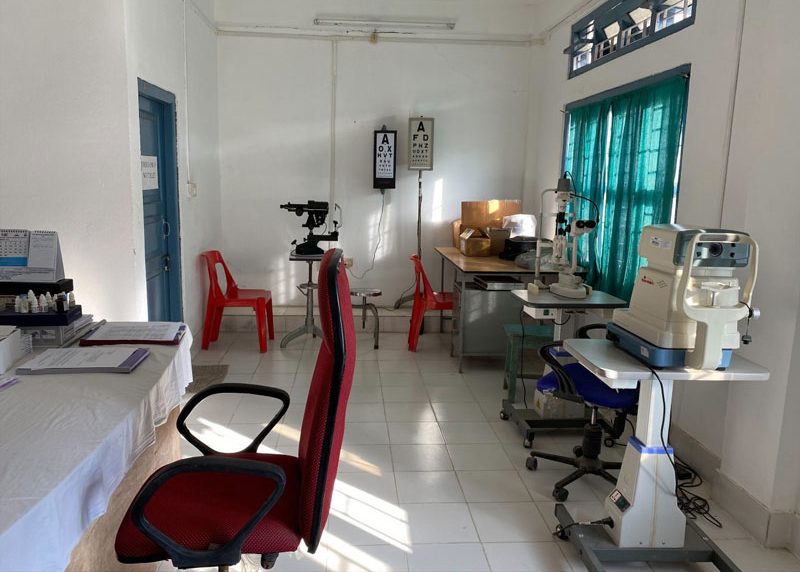December 2021
Scalability, replicability, sustainability and value for money are often hallmarks of successful projects. Operation Eyesight, working to eliminate blindness and restore sight in India for almost 60 years, is achieving success through its efforts to integrate primary eye care into a nation-wide primary health care system.
Blindness and visual impairment continue to be a major public health issue in India, which is home to more than 20 percent world-wide of those who are visually impaired or blind. Incredibly, 90 percent of this is avoidable; conditions that cause blindness or visual impairment can be treated or prevented.

Availability and access to primary eye care services is essential to eliminating blindness. Following on from “Vision 2020: The Right to Sight”, the Government of India made eye health care delivery an essential component of a comprehensive primary health framework to ensure quality, affordable eye care services would be available even to its most vulnerable citizens. Allied with Operation Eyesight’s expertise in facilitating eye health, the strategy involved establishing vision care facilities* within already existing government health centres, therefore making eye health care services available to its most underserved populations. By integrating basic eye care into the existing primary health care system, the resulting solution makes the best use of existing assets, is cost-effective and practical, and brings services within reach of the people
With its decades of experience in addressing visual impairment in India and a tried-and-true model of integration with primary health care, Operation Eyesight took on the task of operationalizing the plan: establishing the vision care facilities, training existing staff and acquiring the necessary diagnostic equipment and tools to outfit the centres. With the vision care facilities being under the auspices of the state government, equipment in place and personnel trained, these locations are poised to treat those most in need of eye care for many years to come. Having traditionally worked with private and non-profit health partners in India up to now, the move to work with the state and national governments to establish quality eye care services is a new direction for Operation Eyesight. Currently, no other international non-governmental organization is working with the state governments to accomplish these goals.
Building the capacity of vision care facilities within the country’s national health care system ensures that services do indeed reach the most disadvantaged populations, as patients who are able to pay most typically seek care at for-profit facilities, rather than attending government services.

The training of local professionals and paraprofessionals is paramount to building the capacity of local health facilities to sustain the project in the long term. Medical officers, ophthalmic assistants, community health officers, community health mobilizers, and primary health care workers have all been trained to impart or upgrade knowledge about eye diseases, diagnoses, referrals and follow-up care. Unique to this model is the grassroots-level primary eye care workforce, bringing services to the most underserved rural patients.
In partnership with Jhpiego (an affiliate of Johns Hopkins University) and the state Ministry of Health, the project was initially launched in three districts in the state of Arunachal Pradesh. Based on the success of this model, the state government has committed the necessary resources to expand and replicate this plan to seven additional districts in the state, with the goal of ultimately declaring the entire state avoidable blindness-free. Operation Eyesight and our partner Optometry Giving Sight are also replicating the model in the state of Madhya Pradesh, where to date a Memorandum of Understanding has been signed, facilities assessment completed and personnel training commenced. In addition, the state of Meghalaya has also expressed interest and has invited Operation Eyesight to bring our technical expertise to integrating the operation of vision care facilities within primary health care settings, solidifying and extending the reach of accessible eye care throughout that state.
Integrating quality primary eye care services into the existing health care system brings the promise of availability, affordability, accessibility and sustainability to a population in great need. Operation Eyesight, in collaboration with district and state authorities and our other INGO partners, is helping to fulfil this promise.
* “Vision care facilities” is a general term encompassing a variety of types of facilities including Vision Centres and Vision Points. We have established Vision Centres at Community Health Centres (CHCs), Advanced Vision Centres at Distict Hospitals (DHs), Vision Points at Sub-Centre Health and Wellness Centres (SC-HWCs) and Advanced Vision Points at Primary Health Centres (PHC-HWCs).
Vision Care Facilities
Vision Points and Advanced Vision Points are established at facilities at the bottom level of the government health system. Vision Points are provisioned with basic eye care services such as screening/validation of eye conditions, visual acuity measurement and dispensing of medicines. Advanced Vision Points provide the same range of services as Vision Points, in addition to providing services such as management of common eye infections including conjunctivitis, dry eye and trachoma, and identification of common eye diseases such as cataract, presbyopia, trachoma and corneal disease including Vitamin A deficiency.
Vision Centres provide comprehensive eye examination, diagnosis and treatment of refractive errors, foreign body removal, identification of cataract and other corneal diseases such as corneal opacity. Advanced Vision Centres provide the same range of services as Vision Centres, in addition to providing services such as diagnosis of diabetic retinopathy, glaucoma, dacryocystorhinostomy, etc. and pre-cataract surgical diagnostic services.
